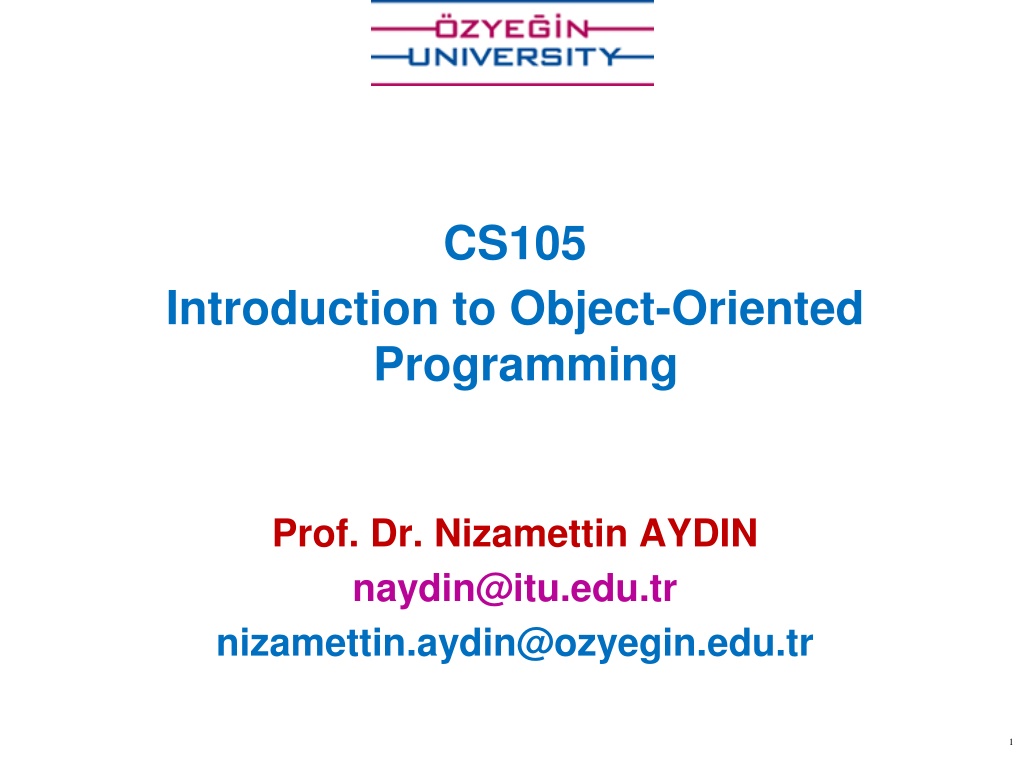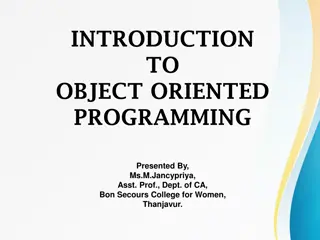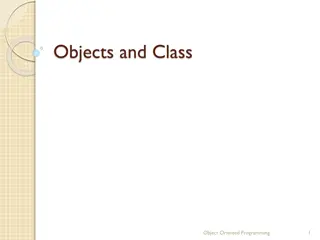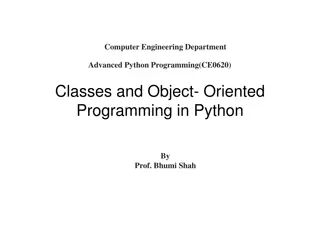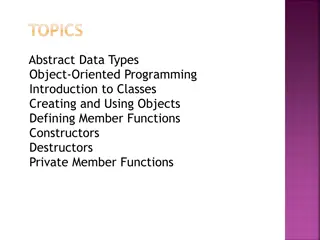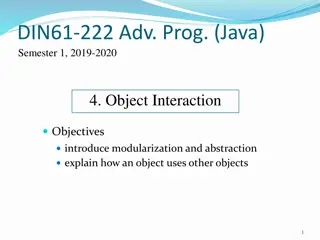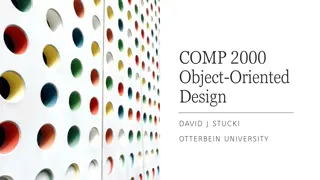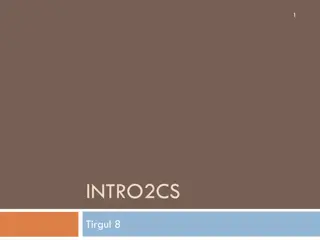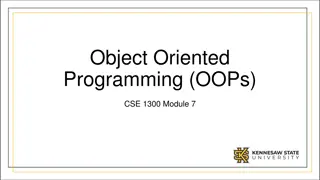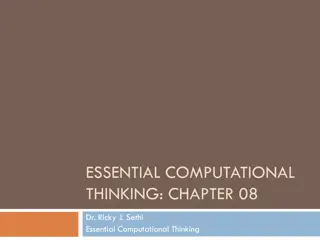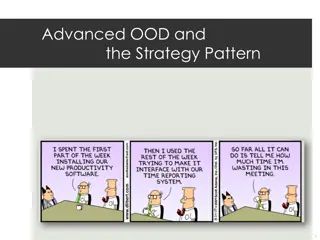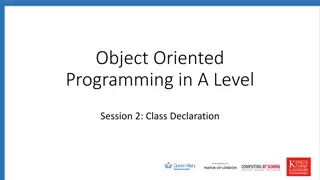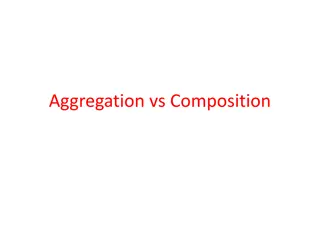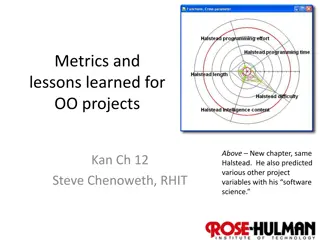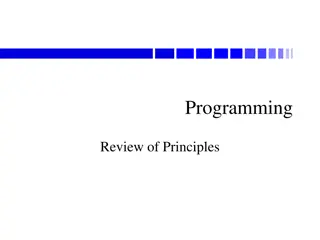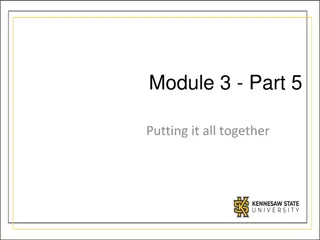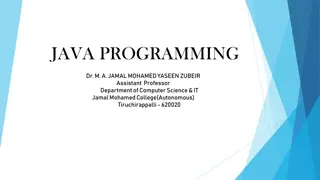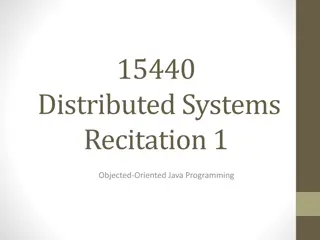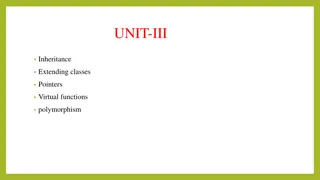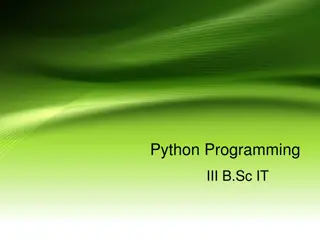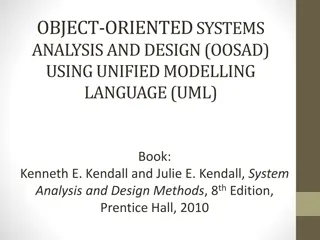Object-Oriented Programming Overview
This content dives into the fundamentals of object-oriented programming through images and text, covering topics such as primitive and object types, memory allocation, bank account implementation, and more. It explores the concept of stack and heap memory, as well as the distinction between primitive types stored in the stack and objects stored in the heap.
Download Presentation

Please find below an Image/Link to download the presentation.
The content on the website is provided AS IS for your information and personal use only. It may not be sold, licensed, or shared on other websites without obtaining consent from the author.If you encounter any issues during the download, it is possible that the publisher has removed the file from their server.
You are allowed to download the files provided on this website for personal or commercial use, subject to the condition that they are used lawfully. All files are the property of their respective owners.
The content on the website is provided AS IS for your information and personal use only. It may not be sold, licensed, or shared on other websites without obtaining consent from the author.
E N D
Presentation Transcript
CS105 Introduction to Object-Oriented Programming Prof. Dr. Nizamettin AYDIN naydin@itu.edu.tr nizamettin.aydin@ozyegin.edu.tr 1
Extending Bank Account Example 2
Outline Primitive types Object types Memory Allocation Heaps Member Functions Memory Model Class Instances Standard Streams Arrays 3
Bank Account Lets implement a bank account program What type of information do we need for a bank account? Account ID (int) Balance (double) Currency (String) 4
Bank Account int and double are primitive types String is an object type What is primitive type? What is object type? 5
Primitive types 8 types byte short (16 bit signed) int (32 bit signed) long (64 bit) float (32 bit floating point) double (64 bit floating point) boolean char 6
Object types Everything else that is not primitive Arrays All other user defined classes An object can be created with the new keyword int [] myArray = new int [10]; When new keyword is used, some space to store this object is allocated from the memory. Where in memory? 7
Bank Account int and double are primitive types String is an object type How are they represented in memory? 8
Bank Account Primitive types are stored in Stack Objects are stored in Heap What is Stack and Heap? 9
Memory Allocation When you declare a variable in a program, Java allocates space for that variable from one of several memory regions: Heap Holds objects created in the program Stack Used during the execution of the program Stack holds short lived objects (local primitive types) When a function is called a block of memory (stack frame) is allocated to hold the local variables. It is removed when the execution of function finishes references to other objects in the heap 10
Memory Allocation Heap vs. Stack Heap holds the objects where Stack holds reference to these objects Objects When new keyword is used, some space to store this object is allocated from the heap memory. Variable declaration: Primitive type int myInt; Object type String myString; 11
Heaps A heap (or, for greater clarity, max-heap) is a binary tree that: is almost complete: all nodes are filled except the last level may have some missing toward the right. all nodes store values that are at least as large as the values stored in their descendants. The heap property ensures that the tree s largest element is stored in the root The shape of a heap is very regular In a heap, the left and right subtrees both store elements that are smaller than the root element 12
Memory Allocation Variable assignment: Primitive type int myInt; myInt = 5; Object type String myString; myString = new String("Text"); 13
Memory Allocation Variable assignment: Primitive type int myInt; myInt = 5; Object type String myString; myString = new String("Text"); Instead of showing the address, we will use an arrow 14
Bank Account Primitive types are stored in Stack 15
Bank Account Objects are stored in Heap Their reference is stored in Stack 16
Bank Account 17
Member Functions Member functions can also be represented in memory diagrams 18
Another class Lets add another class Customer object Name Account 20
Using Customer Class Draw the Memory Model 22
Additional Classes We have customer and account, lets have a bank then. A bank has a name and customers. Bank Class Class Instances: Only one name but multiple customers. name (String) customers (array) How many customers? Need to know in advance, why? 32
Bank Class Class Instances Lets say a bank can have at most 3 customers. Create an array of size 3 But you don t have to use all 3 customers. It can be less. Therefore keep the number of customers value in a variable. 33
Bank Class - Constructor Initially banks have no customers. What should be the constructor arguments? 34
Bank Class Adding Customers An addCustomer method to add customers. This method takes one customer as an argument. It updates the array and the numCustomers value. 35
Bank Application Assume that we have an application which takes customer information in runtime from users. We need to use Scanner in order to read the input from the console. 37
Bank Application For each customer, what kind of information do we need? Name Account Balance Currency Number? The system can assign the next available account number to the account. Need to keep a counter for account number. 39
Memory Model? What will be the memory model after user enters Ali for customer name TL for account s currency 100 for initial balance How many objects are we going to create? 41
Memory Model The path is from inside out. User entered "TL" for account s currency 100 for initial balance Return its reference to Customer constructor. 42
Memory Model Save customer s address at bank s customer array 43
Memory Model 44
Memory Model 45
Arrays Arrays are fixed length. We need a data structure that can be resized. ArrayList ArrayList Dynamic in size See ArrayList slides ... 46
Bank Class with ArrayList We don t need numCustomers anymore. 47
